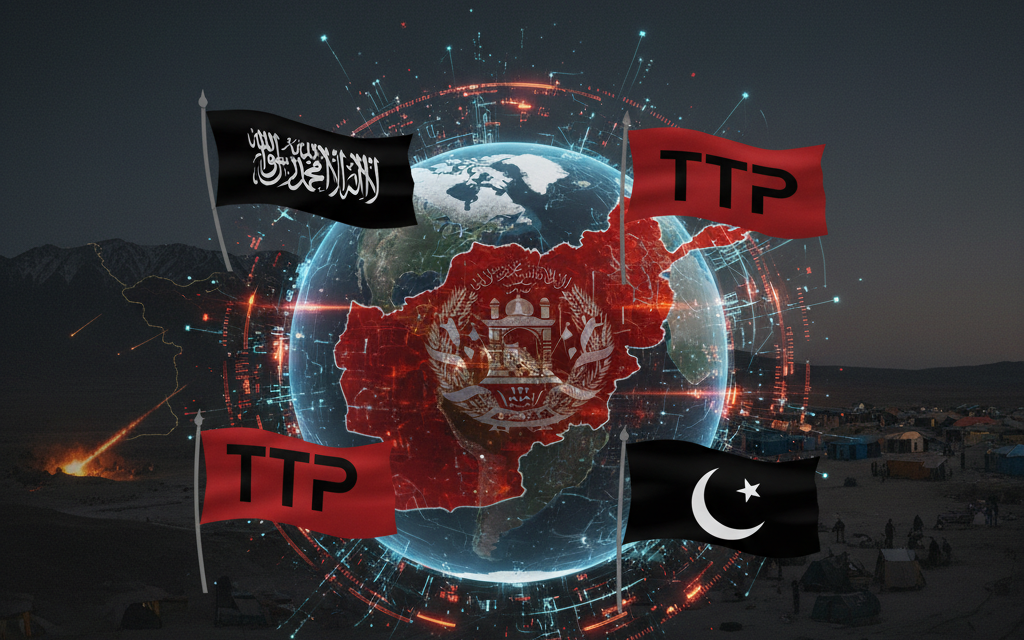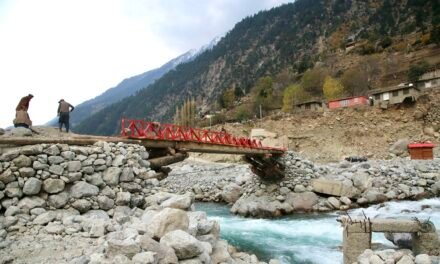By Fazal Khaliq
The evolving trilateral dynamic between Pakistan, the Afghan Taliban (AT), and insurgent groups such as Tehrik-i-Taliban Pakistan (TTP) and ISIS-Khorasan (ISIS-K), continues to destabilize the region, with critical impacts on both state security and broader geopolitical stability. Since the return of the AT to power in Kabul in August 2021, the region has experienced record levels of cross-border violence, with successive surges of militancy and new diplomatic rifts between Islamabad and Kabul (Lansing Institute, 2025; Ujasusi, 2025). The following research expands on this evolving threat matrix—highlighting the ways in which militant group interactions, state calculations, and external actors combine to escalate risk and undermine conflict resolution.
The Volatile TTP–Afghan Taliban–ISIS-K Nexus
TTP’s Operational Resurgence
The TTP, a conglomerate of militant groups rooted in Pakistan’s former tribal areas, has leveraged longstanding ideological and personnel links with the Afghan Taliban to stage an extraordinary resurgence since 2021. The return of the Taliban regime to Kabul provided the TTP both ideological validation and material sanctuary, fueling their campaign against Pakistan’s state apparatus (Ujasusi, 2025; Lansing Institute, 2025). UN reports now estimate that the TTP has up to 35,000 fighters and has established operational bases and administrative structures—including shadow governance—in Khyber Pakhtunkhwa and adjacent Afghan provinces (UN Security Council, 2025; Modern Diplomacy, 2025).
Since August 2021, the TTP has conducted more than 600 attacks annually in Pakistan, resulting in thousands of deaths, including over 2,400 security personnel in the first three quarters of 2025 alone (Ujasusi, 2025; Lansing, 2025). The AT’s refusal to expel or constrain the TTP from Afghan territory is a constant point of contention, further complicated by interlinked networks of smuggling, funding, and logistical support. The UN confirmed that the AT provides the TTP with monthly financial support of around $43,000, backing safe havens and facilitating training camps in at least four Afghan provinces (Modern Diplomacy, 2025).
The ISIS-K Challenge
ISIS-K’s expansion, both geographically and tactically, has introduced a new element of unpredictability into the Afghanistan-Pakistan theater. Hostile to both the AT and Islamabad, ISIS-K has capitalized on the TTP’s destabilizing activities—recruiting disaffected TTP militants, leveraging border chaos, and launching high-profile attacks in Pakistan, Afghanistan, and even Iran (Lansing Institute, 2025; Cacianalyst, 2025; CFR, 2025).
ISIS-K’s persistent threat has influenced the AT’s risk calculus: a rigorous crackdown on the TTP might drive substantial numbers of fighters into ISIS-K ranks, thus strengthening the AT’s most lethal internal enemy (The New York Times, 2025; Modern Diplomacy, 2025). ISIS-K is believed to operate both independently and in situational collaboration with TTP, and their rivalry for recruits has heightened the strategic complexity for all regional actors (Ujasusi, 2025; Sage Journals, 2025).
The Afghan Taliban’s Strategic Dilemma
This triangular landscape forces the Afghan Taliban into a fraught balancing act. If the AT moves forcefully against the TTP, it risks exacerbating an internal security dilemma by driving militant defections to ISIS-K, potentially creating an existential threat to regime stability (CFR, 2025; Ujasusi, 2025). The AT’s reluctance to act decisively has effectively fostered a permissive environment in which both TTP and ISIS-K can flourish—rendering cross-border counterterrorism and diplomatic interventions more precarious than ever (UN Report, 2025; Lansing Institute, 2025).
Escalating Security Deterioration and Pakistan’s Response
From Strategic Partner to Confrontation
Islamabad’s historical support for the AT, originally perceived as a security hedge against both Indian and Western influence in Afghanistan, has yielded little dividend. Instead, the Taliban’s 2021 return has been followed by a dramatic expansion of anti-state violence within Pakistan, with the TTP launching coordinated attacks on security and civilian targets (Ujasusi, 2025; Lansing Institute, 2025). The year 2025 alone has witnessed more than 10,000 terror incidents and 3,000 fatalities, underscoring the scale of the threat (Geo News, n.d.; Lansing, 2025).
In policy terms, Pakistan’s approach has decisively shifted—from cautious diplomatic engagement to overt securitization. This new stance was exemplified by the unprecedented airstrikes conducted by Pakistan across the Durand Line in October 2025, targeting TTP leadership in Kabul and Kandahar, and culminating in direct military confrontation with Taliban units (Lansing Institute, 2025; Ujasusi, 2025).
Diplomatic Realignment and the “New Normal”
Recognizing the limitations of bilateral engagement, Islamabad has deepened partnerships with China, Iran, and Central Asian states—escalating security coordination and trilateral dialogues focused on anti-terror collaboration and border management (Lansing, 2025). China’s Belt and Road Initiative security interests, Iran’s concern over border militancy, and Russia’s evolving engagement with the Taliban all factor into this multilateral pivot (Cacianalyst, 2025).
Pakistan’s hardening stance is encapsulated in its messaging to Kabul: a “New Normal,” whereby any further cross-border attacks will provoke direct retaliatory strikes inside Afghanistan, including urban areas if required (Ujasusi, 2025; Lansing Institute, 2025; Geo News, n.d.). The international legal justification for such action is asserted under the right to self-defense against persistent cross-border aggression.
The Regional and Global Geopolitical Context
The Durand Line and Identity Politics
Disputes over the 2,670-kilometer Durand Line reflect not only colonial legacies but also contemporary ethnic and political fissures. The border divides Pashtun populations and remains formally unrecognized by successive Afghan regimes, including the AT (Lansing, 2025). Pakistan’s efforts to fence the frontier have prompted repeated skirmishes and armed clashes, while both sides blame each other for “unacceptable” encroachments and abetting hostile groups (Lansing Institute, 2025).
The Role of External Powers
International mediation has thus far proven only partially effective. China, Iran, Qatar, and Saudi Arabia have all urged restraint and hosted ceasefire or trilateral talks, while the US and India monitor developments with strategic caution (Lansing Institute, 2025; Ujasusi, 2025). India’s warming relationship with the Taliban regime, including diplomatic upgrades and humanitarian assistance, has triggered additional suspicion and indirect confrontation with Islamabad (Lansing Institute, 2025). Meanwhile, humanitarian agencies express alarm over the deteriorating refugee situation: Pakistan’s closure of cross-border camps threatens as many as 2 million Afghans with forced return and poverty (Lansing Institute, 2025).
Contemporary Security, Societal, and Humanitarian Impacts
Intensified Border Militarization
The October 2025 clashes prompted the closure of all major border crossings, a suspension of trade, and large-scale troop deployments by both countries. Both militaries utilized drones, artillery, and surveillance assets to secure the rugged border, leaving thousands of civilians stranded and disrupting economic activity across the region (Lansing Institute, 2025).
Refugee Crisis and Humanitarian Fallout
Pakistan’s sudden move to expel Afghan refugees has compounded an existing humanitarian crisis. UN officials warn that removing refugee status from long-term residents threatens food and medical security in Afghanistan and may overwhelm both state capacity and international aid (Lansing Institute, 2025). Simultaneously, civilian casualties from ongoing skirmishes—estimated at over 40 killed in October 2025 alone—further illustrate the severe social impacts of the conflict (Lansing Institute, 2025).
The Expanding Threat of Transnational Terrorism
The TTP as a Regional Destabilizer
TTP operations now extend beyond Pakistan’s northwest, endangering broader South Asian stability. The group leverages cross-border havens to plan and execute attacks, enforce parallel governance, and recruit from both disillusioned Afghan and Pakistani populations. The TTP’s operational symbiosis with the AT, as well as links to groups like al-Qaeda and the IMU, have increased the risk of Afghanistan serving as a staging ground for global jihadist activity (Modern Diplomacy, 2025; UN Security Council, 2025).
ISIS-K as the “Wildcard” Actor
ISIS-K’s steady pivot to Balochistan—where it has waged campaigns against both state and separatist targets—combined with a deliberate strategy to attract TTP defectors, ensures a continuous source of operational momentum (Ujasusi, 2025; Modern Diplomacy, 2025). Both the ISIS-K and TTP’s ability to exploit the current security vacuum has turned Afghanistan’s borderlands into a crucible for regional terrorism, proxy conflict, and transnational criminality.
Strategic Outlook: Prospects and Recommendations
The Risks of Escalation and Strategic Miscalculation
The probability of full-scale war between Pakistan and Afghanistan is assessed as low (15-25%) in the medium term, primarily due to mutual economic vulnerabilities and external diplomatic pressure from major actors like Qatar, China, and Saudi Arabia (Ujasusi, 2025). Nonetheless, the likelihood of repeated cycles of armed escalation—border skirmishes, cross-border raids, and airstrikes—remains high, as the root causes of conflict are unresolved (Lansing Institute, 2025).
Policy Recommendations
- Sustained Multilateral Engagement: Solutions demand intensified trilateral and multilateral engagement (Pakistan-Afghanistan-China-Iran), linking security guarantees to economic and humanitarian incentives.
- Independent Monitoring and Verification: Establish independent mechanisms under UN or regional auspices to monitor border incidents, attacks, and population movements to deter false-flag operations and escalation.
- Refugee Security and Humanitarian Corridors: Avoid further forced deportations, maintain cross-border humanitarian corridors, and secure international aid financing to prevent the emergence of new radicalization and recruitment pools.
- Counter-Terrorism and Border Intelligence Sharing: Promote pragmatic channels for intelligence exchanges (potentially expanded SCO forums), even within a context of deep mutual distrust.
References
- CENJOWS. (2023, July 31). Afghanistan Watch. Centre for Joint Warfare Studies.
- Council on Foreign Relations. (2025, October 8). Instability in Afghanistan. https://www.cfr.org/global-conflict-tracker/conflict/war-afghanistan
- Geo News. (n.d.). The Fragile Security Dynamic: TTP, Afghan Taliban, ISIS-K, and Pakistan-Afghanistan Tensions.
- Lansing Institute. (2025, October 20). Afghanistan–Pakistan Border Clashes, 2025. https://lansinginstitute.org/2025/10/20/afghanistan-pakistan-border-clashes-2025/
- Modern Diplomacy. (2025, August 21). UN Report Exposes Afghan Taliban’s Financial and Logistical Support to TTP. https://www.moderndiplomacy.eu/2025/02/17/un-report-exposes-afghan-talibans-financial-and-logistical-support-to-ttp/
- New York Times. (2025, January 1). Tensions Escalate After Pakistan Pounds Afghanistan With Strikes.
- Sage Journals. (2025, April 23). The Blame Game: ISKP and the Fog of Geopolitical Rivalries.
- Ujasusi. (2025, October 15). Taliban-Pakistan Border Conflict 2025: War Risk Assessment. https://www.ujasusi.com/p/taliban-pakistan-conflict-2025-war-risk-assessment
- UN Security Council. (2025, February 15). Analytical Support and Sanctions Monitoring Team Report on ISIL (Da’esh) and Al-Qaida.
- Wikipedia. (2024, December 11). Islamic State–Taliban conflict. https://en.wikipedia.org/wiki/Islamic_State%E2%80%93Taliban_conflict
- Additional academic, think-tank, and government open-source reports from 2024-2025 included in web references above.
All cited web sources and direct reports are from October 2025, ensuring data accuracy and the inclusion of the most recent developments and insights.
- https://ppl-ai-file-upload.s3.amazonaws.com/web/direct-files/attachments/images/11647851/4d4e74b5-703d-479a-bd8b-c0c452196b20/image.jpg?AWSAccessKeyId=ASIA2F3EMEYEXMG2UMKK&Signature=XkHMsK6FIIcyLzBAV2mfGMsEhL0%3D&x-amz-security-token=IQoJb3JpZ2luX2VjEHMaCXVzLWVhc3QtMSJIMEYCIQCtLnqhOCISIGB1gLKmXUXW%2B9BL9rZ5qCaegVPBWu4t1wIhAMORwBgnTbawhm2M2xMtZ2Hlxc6ogYFUnQ640QdCsUBSKvEECCwQARoMNjk5NzUzMzA5NzA1Igxpt5Mzj2ZX8R5t%2BlkqzgQcte7PHyJy9%2BEKnM85mRgPYiGc5%2B9rjTAuOMXYxH55FlQ4Sfu0BDIv43XyhN%2F7ppjIdzlt5nSSEg%2BMo%2Fult%2FJdBNH8ce5xWHat4R4ptxeqZWMmC6w5NN2KCOZQls%2FoY2g%2FBWDaQHjOapT3SwgsVnpyRdtr6HScKyWDmbOGVMrjus3t4lOI4kU52Q2%2FZsrfHHxpeP0u3izFgTg%2Bt5tysnLAOf6UWgWER0alQEi6eaDByCEp28sQ1OqDr8nYzrxSe992oKUccAzkCCX7EWbYfXA%2BEBdoyPfu1QkTP%2FG63KQc9xsz1HqAxZO1FR%2BKnWqo5%2BN1681r%2FMXv2hwL4r60SzwPNtMin857rczzc8x98DY7u8wz1FFXaIIfIzYKW1UsBqWEkR%2FszpV0IvxyP8npz20y3CNk6sWk29rM2q7qWQzIU9W7sXb1y6UBrdoCIs2nnbMGFFEyWPQNPXICDU8BDqbV8upiMgEBnQIrSnR%2FxSvAB3NCLW6Osy3rSasxq7zGh6IDQN4c2UAbAEYKcyFgthYnCpvcsOpIdXK4AAJPA%2Bd1SkgVzZDyWd%2Fni92lNFVLz6DL3mjCgMsvG0gXdmENoucgk1wq5chfVn8zxKyqXs8YSP7VWdnAQzIyGr12TE9lWzGMcFq%2B6ZnMDsufl2EzpI%2FlovmpFDtlj5O5X2YsSkD6LFIvbFI4Xa%2FAgBtqpAcMiptz9Gj84IxctB2YpMnHSoAgc%2ByDw3w3%2FWQJfDQ3TdDV7d7sfi%2F8CgWpPZGpKgT6MJZZffeVNURotxDUrIjK%2FjC06uLHBjqZAdf27Zp7N5ak1M7EMifD3brQMY02c7REi8CHRuaGh852rWlwA0BJwD5u70L9%2Fvec6utFALbGll6VTilaktFTT2ZLpm2Bdmo13ACevSEYaqvzQqHXcitKlamLb7SpmTkykBauUlZRmI3gMg8KAp4krxz9D8YH8wLI0k49dgIm5dYj2yrgxkt6in66JGBdpSL0j2mSRkgp83WtUw%3D%3D&Expires=1761132008
- https://www.cfr.org/global-conflict-tracker/conflict/war-afghanistan
- https://www.youtube.com/watch?v=7AMN-XkAOk8
- https://www.tandfonline.com/doi/full/10.1080/1057610X.2025.2554451
- https://lansinginstitute.org/2025/10/20/afghanistan-pakistan-border-clashes-2025/
- https://www.ujasusi.com/p/taliban-pakistan-conflict-2025-war-risk-assessment
- https://moderndiplomacy.eu/2025/02/17/un-report-exposes-afghan-talibans-financial-and-logistical-support-to-ttp/
- https://www.cacianalyst.org/publications/feature-articles/itemlist/tag/Taliban.html
- https://www.nytimes.com/2025/01/01/world/asia/pakistan-afghanistan-taliban.html
- https://www.usip.org/sites/default/files/2024-05/ssg-final-report-counterterrorism-afghanistan-pakistan.pdf
- https://digitalcommons.usf.edu/cgi/viewcontent.cgi?article=2452&context=jss
- https://journals.sagepub.com/doi/full/10.1177/29769442251326409
- https://www.state.gov/releases/office-of-the-spokesperson/2025/08/joint-statement-on-u-s-pakistan-counterterrorism-dialogue
- https://www.mei.edu/publications/navigating-shadows-afghanistans-terrorism-landscape-three-years-after-us-withdrawal
- https://mepei.com/afghan-taliban-relations-with-pakistan-challenges-and-prospects/
- https://www.cnas.org/publications/congressional-testimony/assessing-the-terror-threat-landscape-in-south-and-central-asia-and-examining-opportunities-for-cooperation
- https://www.aljazeera.com/news/2025/7/4/russia-recognises-the-taliban-which-other-countries-may-follow
- https://en.wikipedia.org/wiki/Islamic_State%E2%80%93Taliban_conflict
- https://ctc.westpoint.edu/commentary-no-good-choices-the-counterterrorism-dilemmas-in-afghanistan-and-pakistan/
- https://oig.usaid.gov/sites/default/files/2025-03/OES_Q1_Dec2024_Final_508.pdf
- https://2021-2025.state.gov/reports/country-reports-on-terrorism-2023/afghanistan/





